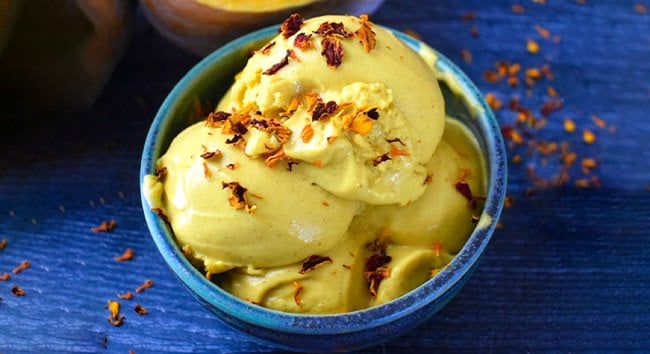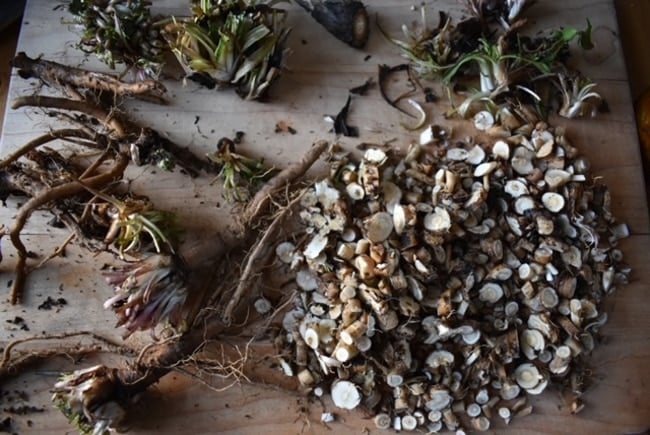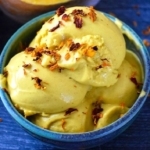New! Holiday Recipe — Golden Gelato Ice Cream

Looking for an unusual and delicious treat for upcoming holiday parties? Try our golden gelato recipe. It’s perfect for eating by itself or as a topping on seasonal pies! (Gelato is a healthier alternative to ice cream with less cream and fewer calories.) Get the recipe and learn about the history and health benefits of its unique ingredients below.
The following gelato recipe is a celebration of the seasonal foraged and farmed harvest at Medicine Circle Farm and a quick recipe to share at the fall table!
Golden Gelato Ice Cream Recipe
Ingredients:
- 3 Cups – Whole Roasted Winter Squash or Pumpkin (or substitute canned)
- 3/4 Cup – Maple Syrup
- 3 Tablespoons – Coconut Sugar or Cane Sugar
- 2/3 Cups – Full Fat Coconut Milk (or Heavy Cream or Milk)
- 1/2 Teaspoon – Sea Salt
- 1 Tablespoon – Vanilla Extract
- 1/2 Teaspoon – Cinnamon
- 2 Teaspoons – Roasted Dandelion Root (optional), finely ground and sifted. (Dandelion root can be purchased online at mountainroseherbs.com or roasted and powdered from Starwest Botanicals on Amazon.)
Directions:
- First, roast the squash or pumpkin. Koginut or Blue Hubbard work well, but any sweet and creamy squash will do. You can also skip this part and use canned pumpkin.
- Preheat the oven to 400°F, and poke several holes in the pumpkin or squash with a sharp knife. Bake the pumpkin or squash on a cookie sheet for about 40 minutes to 1 hour, depending on the size.
- Check for doneness by pressing on the skin. If it gives slightly and is getting soft, then take it out and let it cool completely.
- Remove the seeds and when the squash is cooled, scoop out the squash, add to a blender.
- If you are roasting your own dandelion root (optional), use dry and clean roots, sliced thin in rounds (See photo below). Place on a baking sheet and roast for 10-15 minutes at 400°F, until it is dark brown and really starts to smell like coffee.
- Now, combine all the ingredients in a high speed blender, and blend until smooth.
- Pour into an ice cream maker, and turn it on.
- If you don’t have an ice cream maker, just place in a container in the freezer and stir every 20 minutes until it is creamy and frozen.
- Serve on its own, scoop into a cone, or top your favorite seasonal cookie or pie.
Frost Makes Pumpkins Sweeter
Did you know that frost makes pumpkins and squash a little sweeter? As the frost settles in the morning with its crystalline touch, and the heat of late summer gives way to the welcomed rest of winter, squash and pumpkins concentrate their sugars on the vine and push their last energy underground into their roots.
Pumpkins and squash have grown and been cultivated and enjoyed for more than 9,000 years, with seeds found in Mexico that date to approximately 7000-5500 BC.
The “Three Sisters” Method & Health Benefits Of Squash
Pumpkins and squash are an essential part of the indigenous farming practice in North America called the “Three Sisters.” This brilliant way of growing corn, beans, and squash together means each plant has a role in helping the others to thrive, with the large leaves of the pumpkins or squash acting as a cover for the roots of the corn, preventing weeds from taking hold. Winter squash gets its brilliant orange hue from beta-carotene, and it is an excellent source of Vitamins A, C and potassium.
Roasted Dandelion Root – A Potent Prebiotic And Coffee Substitute
You may think that dandelions are a spring flower, however, fall is a second dandelion season. As the frost returns and the nights lengthen, another important, unexpected fall food is ready for harvest, adding richness and depth to everything it touches: Dandelion roots.
Dandelion roots have been used as food and tonic herbs for thousands of years, with the first written evidence of use coming from China in 600 BC. It is an Arabic, European, North American, Mexican and Welsh traditional medicine plant being used for everything from pain relief to liver cleansing and skin-healing.
Dandelion roots are ideally harvested in the fall, after a few frosts, when the plant creates more prebiotic inulin its roots, and pushes its energy underground for the winter. Dried dandelion roots may also be purchased online.

When roasted, dandelion roots have a rich coffee-like flavor, and have long been used as a coffee substitute. You may drink roasted dandelion root as tea and add it to many desserts in the winter months.
How To Harvest And Roast Dandelion Roots
If you are harvesting your dandelion roots fresh, it is important to make sure you have the correct plant. Using a good foraging book, especially if you are not familiar with the plant.
Dig around the plant, and gently lift the roots out, knocking off the dirt and removing the leaves from the top. The leaves can be saved and eaten or dried and used as a tea. Clean the roots thoroughly in a bowl of room temperature water and let the whole roots dry on a towel.
Preheat your oven to 350°F/180°C.
Chop the roots into thin rounds and tear off the little offshoot roots, setting aside to use for teas, soups or bitters.
Next lay the sliced rounds in a single layer on a cookie sheet and bake for about 30-40 minutes. You want the dandelion roots to get very golden-dark brown, and to begin giving off a coffee-like scent. If you want them to have a milder flavor, take them out around 10-20 minutes.
If you are using dried roots, you will want to watch them closely in the oven, as they may be in smaller pieces and will cook and burn much faster.
Let the roots cool down completely and then grind them in a coffee/spice grinder or blender.
Save the unused, cooled and roasted roots in a glass jar for 6 months to a year.
Grind the roasted roots in a coffee or spice grinder to use for this recipe.
Related Articles
The Illicit History Of Ice Cream Sundaes
Make Your Own Ice Cream Sandwiches
Join The Discussion!
Have you ever made your own gelato or ice cream before?
Have you ever tasted roasted dandelion root before?
Will you try this fun and nutritious recipe?
Let us know in the comments below!

Tara Lanich-LaBrie
Tara Lanich-LaBrie is an herbalist chef, forager, and instructor based in Colorado. She has been working with food and healing for over two decades. Her methodology incorporates seasonal plants and folk medicine into colorful, gluten-free, dairy-free, and refined-sugar-free recipes. Laniche-LaBrie teaches courses on culinary herbalism and foraging, and is currently writing a cookbook. Learn more about her at themedicinecircle.com and on Instagram @themedicinecircle.


